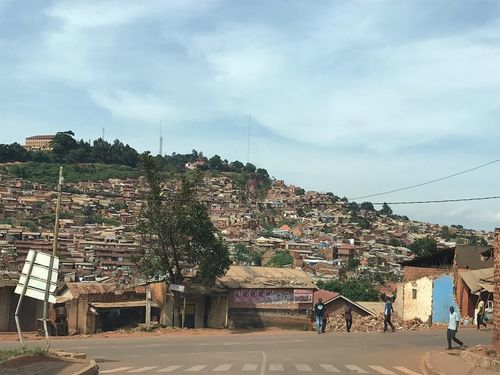
By Rebecca Tumwebaze, doctoral researcher at Kemmy Business School, University of Limerick
Image by author: Part of Kinawataka slum, one of the poorest communities in Kampala, Uganda. Located on 1.2 square kilometres, the slum is home to over 1000 families. People living in such conditions may not understand reasons for a lockdown unless the message is broken down to address their special concerns by someone they easily associate with.
On the 21st of March 2020, Uganda registered its first COVID-19 patient: a 36-year-old Ugandan male who had just arrived from the United Arab Emirates at Uganda’s Entebbe International Airport aboard Ethiopian Airlines. He presented with symptoms of high fever during screening at the airport and was immediately isolated and admitted for testing, which ended up positive for COVID-19.
A few days earlier, the Ugandan Government had taken the decision to close all schools and education institutions because cases of COVID-19 had been reported in the neighbouring countries like Rwanda, Kenya and the Democratic Republic of Congo. Within three weeks from the registration of the first case, COVID-19 cases in the country have grown from 1 to 53 despite the government taking further steps to do a total lockdown of all non-essential services across the country. Unfortunately, it has been challenging to enforce the lockdown with many Ugandans abusing it or disrespecting the Presidential orders to stay home and observe social distance.
Uganda, like most developing countries, has a high number of people living below the poverty line.
According to the 2016/2017 Uganda National Household Survey by the Uganda National Bureau of standards, 21.4 per cent of Uganda’s population live below the poverty line. This means that there are over 10 million Ugandans whose personal income lies below the poverty line, which is approximately € 1.10 a day. The main characteristics of Uganda’s poor include small land holdings, large families, female-headed households, illiterate, malnourished, limited access to credit due to lack of collateral security, limited access to basic services (electricity, water, medical services, and education), unemployed, political powerlessness, socially disadvantaged, and prone to diseases. According to a report by the Ministry of Health, Uganda also has about 1.4 million people living with HIV, 800,000 people living with diabetes, 4.8 million people living with hypertension and the country registers over 100,000 cases of tuberculosis per year. Generally, the prevalence of critical illness in Uganda and other developing countries is normally high.
Behind an apparent vulnerable state of the people, the capacity of Uganda’s health system is known to be fragile and characterized by issues such as inadequate number of trained health workers, unmotivated health workers, poorly maintained infrastructure, unreliable supplies of medicines and personnel protective gear and inadequate funding, among others.
Uganda generally has a very low ICU bed capacity, with major intensive care units (ICUs) mostly found in large hospitals in urban or metropolitan areas. An academic research study by Atumanya et al., (2020) (https://bit.ly/2UQYbJk) confirmed that Uganda, a country with over 45 million people has only 55 functional ICU beds. While the government has denied these findings and claims to have over 500 ICU beds, it is clear that the ability of Uganda (like most developing countries) to absorb a possible surge of patients with COVID-19, is questionable. Unfortunately, when epidemics such as COVID-19 strike, the quality of health systems determines both the socioeconomic and the death tolls in a country. This spells doom for Uganda and other developing countries which have inadequate health systems. If this epidemic continues, more patients will need hospitalization and intensive care, which will stretch an already fragile health system.
The best option therefore is that the government takes decisive measures to halt the transmission of COVID-19 to avoid breaking the already fragile health system and deep, damaging impacts on people and the economy.
The Government of Uganda has enforced a 14-day lockdown across the country as well as heightened surveillance to identify suspected cases and their contacts, among several other technical measures to control spread of the virus. However, these have not been easy to enforce considering the laxity among the population to adhere to the lockdown and a general belief among Ugandans that COVID-19 is a simple cold which only kills the ‘white people’ and not the poor black African who has for long suffered from more complicated diseases than influenza. Media reports also show that suspected cases of COVID-19 have been escaping from isolation centres and contacts of victims have often been uncooperative and do not accept to be quarantined. Uganda being one of the poorest countries in the world, with high levels of illiteracy and a people who live their day-to-day from hand to mouth through informal casual jobs, it is possible that many people see no need to worry about ‘minor cold’.
To change the mindset of the people while implementing government’s efforts to curb the pandemic, a knowledge management approach consisting of the following steps should be employed by the Government of Uganda (and other Sub-Saharan Governments):
- Knowledge dissemination: Knowledge is not just information but rather information that is modeled to be useful to an audience. Knowledge dissemination therefore should aim at ensuring that people do not undermine the impact of the COVID-19 lockdown in the country. Dissemination should ensure not just full disclosure but explanation of the impacts of the virus on every person in society. In the initial Presidential address (https://bit.ly/2UTke2d) about the virus, while highlighting the plight of the virus on the young people, the president said, “…an infected person may not even know that he/she has any problem and may defeat the virus without even knowing that it ever attacked him or her”. In my opinion, this could have led to the laxity of the largely young population about the effect of COVID-19. Information therefore should be modeled into knowledge that will be taken with the seriousness required for all people, at all levels, in urban and village centres to be concerned about their role in combating the virus
- Clustering of the population and development of targeted messages: In a case of a pandemic, the ‘one message suits all’ approach may not be effective. People must be clustered according to their different characteristics and relevant messages developed for dissemination to the clusters.
- Capacity building of knowledge champions: In a country where communication infrastructure may not reach every person, it is important that communication and knowledge dissemination are decentralized to the lowest level of the society. Identification of knowledge champions who are opinion leaders and other common persons including from the local council levels is required, along with capacity building with such identified persons to ensure that relevant knowledge is not lost in translation during dissemination. Champions, while observing social distance and wearing protective gear, should move door to door or community to community while disseminating knowledge about the pandemic. In cases where the media can be utilized, champions should utilize mass media to reach big groups of people.
- Demonstration of messages: Messages should not only be spoken or written but also practically demonstrated by the knowledge champions. Research has shown that knowledge is easier shared through practice. If champions are talking about hygiene for example, they should go ahead to demonstrate handwashing to people in a given community. If they talk about social distance, it could be demonstrated together with the audience. Generally, the audience should be involved in demonstration of these messages.
These steps would play a major role in getting buy in and the support of the population while governments and technical teams work towards containing the pandemic.
ABOUT THE AUTHOR

Rebecca Tumwebaze is a doctoral researcher at Kemmy Business School, University of Limerick. She has previously worked as a Knowledge Management and Communication specialist for the World Bank - funded Agriculture Cluster Development Project (ACDP) in Uganda. Rebecca also worked as a Lecturer at Uganda Technology and Management University.
DSAI provides a platform for dialogue for development studies research, policy and practice across multi-disciplinary perspectives. This opinion piece is published as part of DSAI's call for contributions to our COVID resource section; as a space for pooling and sharing knowledge. Content is published with permission of the author. Views expressed are the author's own.